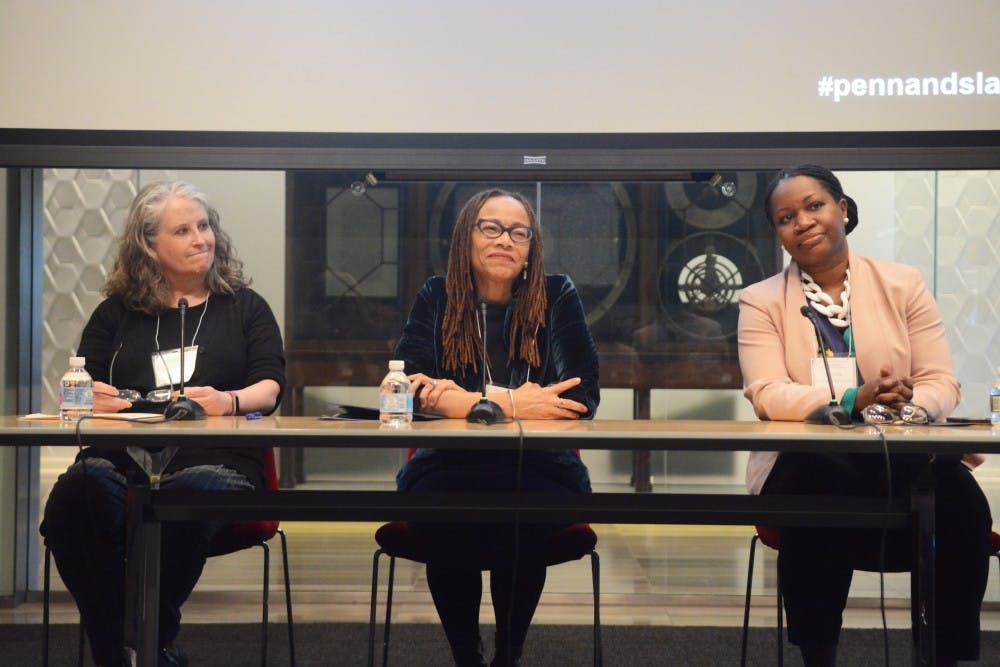At a symposium hosted by the Penn and Slavery Project, students and faculty presented new research on Penn's ties to owners of enslaved people and Penn students' contributions to racial discrimination in medicine in the 1800s.
The symposium, which was a two-day event consisting of panels by historians and presentations by students, took place on April 3 and 4 and was also co-hosted by the Program on Race, Science, and Society. Members of the Penn and Slavery Project, which was previously known as the Penn History of Slavery project, also introduced their new project — an app that gives an augmented reality campus tour where users can view historical information from their phone at certain locations.
In 2017, an undergraduate student research study, titled the "Penn Slavery Project" and supported by Penn's History department, found that many of the University's founding trustees had substantial connections to the slave trade. Since then, student researchers and faculty have discovered that 75 of Penn’s former trustees were owners of enslaved people, including Penn’s first provost William Smith.
Penn responded to the students' findings by forming its own working group to investigate the University's ties to slavery after meeting with the students who were part of the research group. The findings were a reversal of Penn's denial in 2016 that Penn had no direct ties to slavery.
During the symposium, a student researcher part of the Penn and Slavery Project, College sophomore Sam Orloff, said the University took fundraising trips to solicit donations from wealthy owners of enslaved people in South Carolina and Jamaica in 1771 and 1772, raising the equivalent of 14 percent of the University’s total worth at the time.
Christopher D.E. Willoughby, a scholar-in-residence in the Lapidus Center for the Historical Analysis of Transatlantic Slavery at the Schomburg Center for Research in Black Culture in New York City, said 1855 Penn Medicine student John Ramsay McDow's dissertation showed evidence that he supported genocide for people of African descent.
In his thesis, McDow used data collected by white people in Africa to claim that African descendants are genetically built for labor in the tropics, Willoughby said.
Willoughby said McDow's supposed notions of anatomical distinctions between black people and white people was shaped by 1820 Penn Medicine graduate Samuel George Morton. Willoughby said Morton’s skull collection showed significant differences between the skulls of white and black males and oriented much of medical students’ approach of the race and the anatomy of the skull.
RELATED:
Penn used bodies of enslaved people for teaching purposes after death, student research reveals
Penn has acknowledged its ties to slavery, but student researchers say their work is far from over
“Before his death, Morton was probably the single most important figure shaping how physicians talked about blackness,” Willoughby said. “He even made casts of 10 representative racial skulls purchased by universities and medical schools such as Harvard Medical School and [South Carolina College].”

Wendell Pritchett, the 30th Provost of the University of Pennsylvania.
Willoughby added that McDow concluded his dissertation with the racist exclamation, “That in future histories of Africa, historians will only be able to say, 'The negro was born, he was wretched, he died.’”
Penn and Slavery Project student researcher and College junior Brooke Krancer also presented findings on Benjamin Rush, a 1769-1789 Penn Chemistry professor. While Rush advocated for the abolishment of slavery, Rush owned an enslaved person and taught ideas that would later be the basis for race science studies at the medical school. Krancer added that Rush claimed that black skin color was caused by leprosy and facilitated the idea that blackness was a pathology that could be cured.

“Rush’s research provided a platform for teaching racial difference at Penn,” said Krancer, who is a former Daily Pennsylvanian editor. “This research proves that even a 'good' intellectual, who was president of the Abolition Society and was considered progressive, helped to justify the institution of slavery with his own theories of racial difference.”
Daina Ramey Berry, a History professor at the University of Texas at Austin, said at a panel that an underground market of bodies, which she calls the domestic cadaver trade, traded black bodies to medical institutions such as Penn for experimentation and research.
Public History Fellow at Penn and Slavery Project VanJessica Gladney introduced their new project, “Reimagining Penn’s History through Augmented Reality.” In fall 2019, the project will officially launch an app that generates an augmented reality tour throughout Penn’s campus to further reveal the history of Penn’s connection to slavery.
The symposium also displayed two sample augmented reality exhibitions in which people used the app “Zappar” to scan a portrait of William Smith, who was the Penn Provost in the early 1800s, and a painting of an enslaved man, Caesar, and Ebenezer Kinnersley, a professor who worked alongside Penn founder Benjamin Franklin. The app scanned the paintings and viewers experienced an audiovisual history lesson on their phone.

Drexel Professor of Medicine Steven Peitzman said he appreciated the undergraduate students' research.
“There are certainly people in Philadelphia who don't want to talk about it and don’t want to hear about these discoveries, who want to think that we are behind the problem of racial tensions and disparity despite all of the evidence opened to their eyes,” Peitzman added.
1990 College graduate Evangelia Biddy said it was "responsible" that Penn has acknowledged its ties to slavery.
“It’s creating an opportunity for a different discussion and different dialogue. I think at this time at our history and the country’s history, it’s important that we acknowledge all history that America has come through, even in the ugliness of it we have to bring it out in the light of day,” Biddy said.
Deputy News Editor Julie Coleman, Contributing Reporter Maddy Strohm, Contributing Reporter, Jason Yan, and News Editor Max Cohen contributed reporting to this story.









